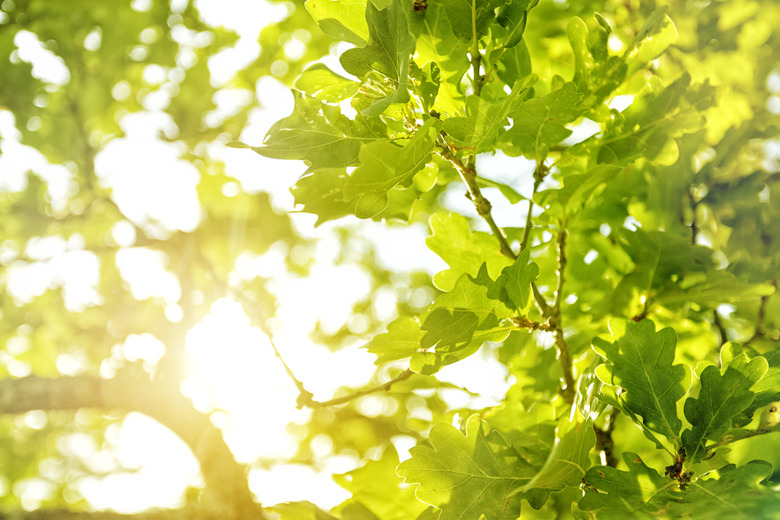How Long Does Photosynthesis Take?
Photosynthesis is the process used by plants, algae and some bacteria to turn inorganic molecules and light energy from the sun into usable chemical energy to fuel cellular function. For photosynthesis to occur, the organism requires sufficient carbon dioxide, water and light. These raw ingredients are funneled into organelles within the cells called chloroplasts, which convert this energy into usable glucose and oxygen as a byproduct. Photosynthesis time varies between species and the local environmental conditions.
How Fast Does Photosynthesis Occur?
How Fast Does Photosynthesis Occur?
The speed of photosynthesis changes depending on the environmental light intensity, carbon dioxide and water availability, temperature and the amount of chlorophyll present in an organism. All these factors change throughout the day so how fast photosynthesis occurs is continually variable. In addition to daily cycles, the rate of photosynthesis changes throughout the seasons. This is why in winter, when temperatures are cold, many species of trees shed their leaves to go into a dormant state as their photosynthetic processes are too inefficient to balance the energetic cost of maintaining their leaves.
Limiting Factors of Photosynthesis
Limiting Factors of Photosynthesis
On one end of the scale, photosynthesis cannot occur without sufficient quantities of light, carbon dioxide, water or heat. Therefore, as each of these factors' availability increases, the rate of photosynthesis also increases. However, infinitely increasing each of these factors doesn't continually enhance the speed of photosynthesis. This is because there are thresholds of each factor that are eventually too high and stop cells from functioning efficiently. The level where a factor, such as light, is too high for the rate of photosynthesis to increase is called the compensation point.
Different organisms have different compensation points depending on their environmental adaptations. For example, shade-adapted plants have a lower compensation point for light intensity than plants suited to full-sun environments.
Some organisms can also adapt when growing in less ideal environments. For example, the aquatic alga, giant kelp (Macrocystis pyrifera), increases the chlorophyll pigment concentrations in its fronds when planted in lower light conditions. However, when growing under lower lights, giant kelp photosynthesize at relatively the same rate as their higher-light counterparts.
The full potential for maximum photosynthetic speed and efficiency of organisms is largely unknown because carbon dioxide is a limiting factor in Earth's current atmosphere. Currently, the Earth has a concentration of carbon dioxide of approximately 0.04%. However, studies on plant growth have found plants perform better in environments with 4% carbon dioxide.
How Long Does Photosynthesis Take?
How Long Does Photosynthesis Take?
There are three ways to measure how long photosynthesis takes:
1. Record the rate of oxygen being released from a photosynthetic organism.
2. Quantify the rate of carbon dioxide being taken in.
3. Assess the rate of carbohydrate production.
A standard method for measuring photosynthesis is to place an aquatic plant, like Cabomba spp., in a controlled environment and then count the number of oxygen bubbles produced per minute. Next, to assess light's effect on photosynthesis rates, a light bulb is moved closer and then further away. Changes in the number of bubbles produced per minute at different light levels will indicate how long photosynthesis takes under each condition.
Similarly, carbon dioxide measurements would indicate how much is being taken up. For this experiment, scientists place plants in chambers and measure the carbon dioxide going in compared to the percentage of carbon dioxide exiting. Overall, it is estimated that it takes all the photosynthetic organisms globally one year to fix 15% of the Earth's atmospheric carbon dioxide.
Fast Photosynthesizers
Fast Photosynthesizers
Since organisms use photosynthesis to create glucose energy for growth and cell functioning, measuring growth rates can indicate photosynthesis rates. The fastest-growing, and therefore likely one of the fastest photosynthesizers on Earth, is the giant kelp, a type of algae. Algae are not true plants but instead belong to the kingdom Protista. In the wild, this species can grow up to 20 inches a day and, under optimal laboratory conditions, can double its size in less than 30 days. For an organism that can grow up to 174 feet high, this is impressive.
References
- Sanctuary Simon: Giant Kelp
- Science and Plants for Schools: Measuring the Rate of Photosynthesis
- Essays in Biochemistry: Photosynthesis
- National Center For Biotechnology Information: The Cell: A Molecular Approach. 2nd Edition: Photosynthesis
- Royal Society of Chemistry: Rate of Photosynthesis: Limiting Factors
- BBC Bitesize: Photosynthesis – AQA
- Marine Biology: Pigment Content and Photosynthetic Rate of the Fronds of Macrocystis Pyrifera
Cite This Article
MLA
Jerrett, Adrianne. "How Long Does Photosynthesis Take?" sciencing.com, https://www.sciencing.com/how-long-does-photosynthesis-take-13428306/. 2 November 2021.
APA
Jerrett, Adrianne. (2021, November 2). How Long Does Photosynthesis Take?. sciencing.com. Retrieved from https://www.sciencing.com/how-long-does-photosynthesis-take-13428306/
Chicago
Jerrett, Adrianne. How Long Does Photosynthesis Take? last modified August 30, 2022. https://www.sciencing.com/how-long-does-photosynthesis-take-13428306/
